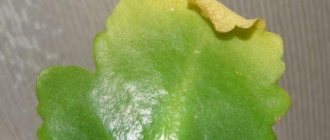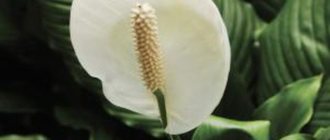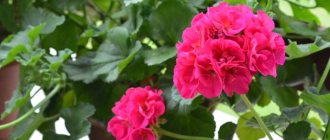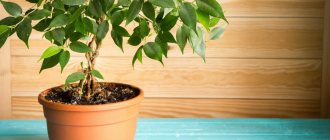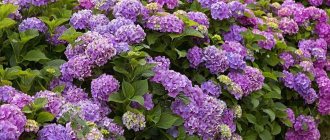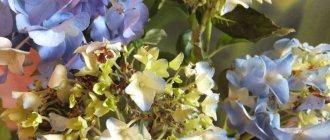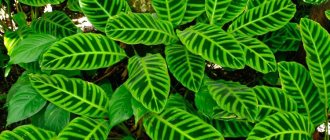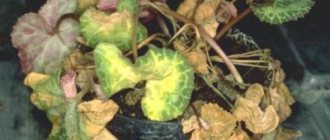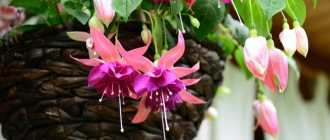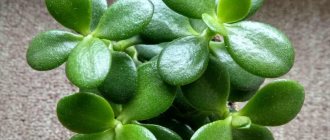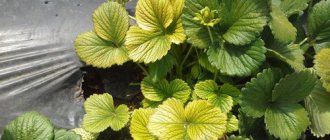Yucca leaves dry out and turn yellow - what could be the reasons?
There are many reasons why yucca leaves turn yellow. In most cases, the process occurs as a result of improper care of the flower. If you do not take the necessary measures in time, you can lose the plant.
Yucca leaves can turn yellow for various reasons.
The main reasons that provoke yellowing of yucca foliage are the following:
- physiology,
- lack of nutrients
- improper watering,
- unsuitable air temperature,
- violation of the light regime,
- damage by harmful insects,
- various diseases.
Attention! Often, failure to follow the rules of care leads not only to problems with the leaves, but also to the death of the entire flower.
Other Possible Problems
Why do rhododendron leaves turn yellow and what to do?
What other reasons could there be and what should you do if the leaves of the yucca palm turn yellow and dry? These problems can be of different nature.
Natural leaf shedding
From time to time, the lower leaves of the palm tree turn yellow and dry out. This is a sign of maturation and growth. The palm tree does not know how to shed dry leaves on its own. In order not to spoil its appearance, you need to pull the dry leaf down and carefully remove it from the trunk.
Lack of light
Yucca can grow in shade, but loves when there is enough light. In late autumn, when daylight hours are shortened, the exotic beauty suffers. It is necessary to organize artificial lighting for the plant so that its daylight hours are at least 10 hours.
Stress
After purchasing the plant, yellowing and drying of the greenery may occur. This is a reaction to a sharp change in conditions of detention, furnishings, and lighting. There is no need to rush to replant the palm tree in new soil. 10-14 days of adaptation will help the plant come to its senses.
Stress response causes yellowing of leaves other than just below
Rearrangement
Yucca is a homebody, and frequently moving it from place to place can also affect its decorative value. The leaf may wither, turn yellow and dry out. During such periods, flowers are especially weak to pests and diseases.
Note! The plant can easily tolerate rearrangement due to the change of season. In winter, this is a cooler room. In summer, yucca feels great in the open air of balconies and verandas.
No rest period
Most often, yucca begins to turn yellow precisely because of improper wintering. Conditions that spoil the appearance of a palm tree:
- heat;
- dry air;
- lack of light.
The ideal dormant period for yucca is:
- air temperature 15 °C;
- moderate air humidity;
- rare watering;
- sufficient lighting;
- daylight hours more than 10 hours.
Properly organized wintering ensures the preservation of decorative properties. And already in the spring, after awakening, the palm tree actively begins to grow green.
Rough soil change
The exotic root system is not very developed and very delicate. If you vigorously shake out old soil, the roots are easily damaged. After the transplantation procedure, the palm tree grows and restores roots for a long time, so it stops growing and can even shed the lower rows of leaves.
A regular palm tree transplant looks like transshipment. It is this procedure that will save the root system. And after the transplant, she will quickly restore her growth. Yellowing of a pair of leaves after transplantation is considered normal.
Important! If the roots of the flower are damaged during transshipment, they should be treated with crushed coal.
Yucca is a wonderful representative of the Agave family. This is a worthy decoration for any home, office or hall. The plant is not capricious, and its care requirements are easy to recreate in an ordinary apartment.
Diseases
Geranium diseases, geranium leaves turn yellow and dry - what to do?
Often the reason why the tips of yucca leaves dry out is the presence of various plant diseases. Improper and excessive watering, hypothermia of the flower often cause the development of fungal diseases. Unfortunately, they are quite difficult to notice. The main symptom is a change in the appearance of leaf plates without any apparent reason.
To save the plant, you need to stop watering and treat the yucca with special fungicidal agents. You may need to transplant the crop into another pot.
Yellow leaves occur due to various diseases
Attention! Often fungal diseases lead to the complete death of the plant.
Pests
Violation of the decorative appearance of the plant and problems with the leaves can occur when the flower is damaged by various pests. The following are considered the main ones:
- scale insect,
- aphid,
- spider mite
These are pests that suck all the juices out of the flower. As a result, the palm tree lacks nutrients, the tips of the yucca leaves dry out, they curl and fall off. The appearance of parasites can be caused by improper watering, inappropriate air temperature, or reduced plant immunity.
Anthurium flower: leaves turn yellow - what to do
Pest control should begin immediately after detection. Otherwise, there is a risk of losing the entire plant. Damaged leaves are removed, insects are removed by hand or using a soap solution.
However, in most cases it is easier and faster to get rid of parasites by using special chemicals. You can use such products as Fitoverm, Aktara, Aktellik. The solution must be made according to the instructions.
[ Important! You can save a flower if its root system is not damaged./alert]
Growing Yucca from Seeds
Yucca seeds photo
The most commonly used method is seed propagation of yucca.
- Seeds must be scarified: carefully break the dense shell of the seed with a needle or rub with sandpaper.
- Fill the box with a mixture of leaf, turf soil and sand in equal proportions. Plant the seeds to a depth of 2-3 cm.
- The distance between the seeds is 3-5 cm, but it is better to plant them immediately separately in cassette or peat cups.
- Cover the crops with glass or film. Sprout at an air temperature of 25-30 °C and bright, diffused lighting.
Yucca from seeds photo seedlings
- Ventilate the shelter daily to remove condensation.
- In the first 10 days, maintain constant soil moisture, then moisten moderately.
- Shoots will appear in about a month.
- When 2 true leaves appear, plant them in separate containers with light nutrient soil.
- After 2 weeks, feed (1 g of nitrophoska per 1 liter of water).
- When 4-5 leaves appear, transplant into a pot and care for it as if it were an adult plant.
Soil moisture
Ficus benjamina - leaves turn yellow and fall off, what to do.
Improper watering is also one of the reasons that yucca leaves turn yellow and fall off. This flower easily tolerates dry periods due to its structural features. The plant has a rather thick trunk, in which moisture accumulates, like succulents. The leaf blade has a fairly dense surface, which protects against rapid loss of moisture. Therefore, overwatering is detrimental to yucca.
Excessively wet soil provokes rotting of the root system, the leaves may turn yellow and fall off. To avoid this problem, you need to carefully follow the watering regime - the soil should not be constantly wet.
Attention! Lack of watering also negatively affects the condition of the crop; yucca does not like this and may dry out.
Irrigation of the flower is carried out when the soil in the pot is at least half dry. Watering is carried out with settled warm water, from below to the root.
High humidity can cause leaves to rot
Cold liquid causes rotting of the roots or base of the trunk. Such a plant can only be saved by replanting it in another soil.
Plant care: how to properly care for it
Yucca is a plant that requires virtually no special care from the gardener. The most important thing when growing this species is to choose the right place for planting it, prepare the soil well, and then water and feed it from time to time. For better growth of yucca throughout the year you should:
- carry out periodic loosening of the soil: good drainage and aeration of the yucca planting site;
- for the winter, bring flowerpots with yucca into the house or wrap plants in the garden with thick paper;
- monitor the level of moisture in the soil;
- periodically treat the leaves with pest control agents.
The last point when growing a garden species needs to be given a lot of attention. Yucca is a plant that is susceptible to pests. Read about planting morning glory in open ground in this material.
Common enemies of this shrub are slugs and snails, which eat fresh leaves.
It is quite easy for an experienced gardener to get rid of them. To do this, it is quite enough to treat yucca leaves with general-purpose insecticides from time to time. It is recommended to carry out such activities in the spring for preventive purposes. A more dangerous but rare problem for yucca is scale insects, a small pest that is resistant to chemical treatments. It must be collected manually. The process of removing this parasite usually takes several weeks.
Watering
For yucca, it is worth determining a moderate watering schedule. It must be remembered that this plant categorically does not tolerate high humidity and with poor soil drainage it dies quite quickly. To avoid overwatering the yucca, it is recommended to ensure that the plant’s soil is relatively dry and not to allow moisture to accumulate near the rhizome. In this article you can learn a lot of new things about how to care for and grow Buttercup.
If you cannot determine the watering schedule yourself and are afraid of destroying the plant, focus on the general condition of the yucca. When it requires moisture, its leaves begin to curl and its threads begin to sag.
Top dressing
The plant needs to be fed once every 2-3 weeks, but only during the period of most intensive growth, especially in the summer and spring months. For this purpose, it is recommended to use standard garden mixtures for yucca. During the winter season, plants are not fertilized. Read about growing Lychnis Rosetta here.
You cannot fertilize yucca if the plant has not yet acclimatized in the open ground, as well as before replanting or during illness. During such periods, your flower should be in a state of complete dormancy.
How Azalea transplantation occurs can be understood from the article.
Find out where Lavender grows and what are the conditions for its maintenance at this link.You can see what the Aquilegia flower looks like here: https://2gazon.ru/ozelenenie/cvety/akvilegiya-osobennosti-posadki-i-uxoda-za-rastniem.html.
Air temperature
The ambient temperature for yucca is no less important than proper watering. Incorrect temperature conditions affect the condition of the leaves - they dry out, curl and fall off.
The best temperature for yucca (elephant and other species) is considered to be in the range of 20 to 25 degrees. Under such conditions, the plant develops well and does not get sick.
A sharp change in indicators, constant drafts, cold or heat lead to the fact that the crop begins to get sick and quickly dies. Therefore, it is important to provide yucca with the most suitable conditions for growth and development.
What does yucca look like?
Tree-like trunks of yucca, with one or several growth points, can be crowned with drooping or erect narrow long leaves. With the help of proper pruning, the trunks can be given fancy shapes and the desired branching. Yucca can bloom and bear fruit only in natural conditions, where they are pollinated by special butterflies. Flowering of decorative varieties can be expected extremely rarely and only from hybrids.
If favorable conditions are created and tireless care is provided, domestic yucca can bloom only after 6-7 years. This event happens in the summer. But experienced gardeners have learned to stimulate the formation of flower buds in adult plants by creating cool conditions in winter. The temperature at this time should not exceed 14 degrees. Yucca flowers resemble small white bells and are collected in panicle inflorescences.
Ornamental plant species do not grow fast, but some specimens can reach four meters in height.
All decorative types of yucca have common characteristic features that distinguish them from other plants:
- the crop grows like a shrub or tree with a powerful trunk
- emerald leaves of a dense and hard texture, usually monochromatic, but sometimes diluted with white veins
- leaves, up to a meter long, are collected in rosettes
- panicle inflorescences are formed in the middle of leaf rosettes
After flowering, fruits are formed on the plant - these are berries, which over time turn into seed pods. In indoor floriculture, you can most often find two types of yucca:
- Elephant palm, often called false palm. It is a shrubby plant with long, pointed leaves. Elephant yucca gets its name from its trunk, which thickens significantly with age and resembles an elephant's leg. This species is native to arid regions with few pests, so the plant is characterized as unpretentious.
- Aloe leaf - with leathery, hard leaves reminiscent of aloe leaves. This is where its name came from. To grow this species, you need to make some effort. The crown of an adult plant is spherical and crowned by a thick cylindrical trunk.
All types of yucca have a positive attitude towards fresh air, so in the warm season it is preferable to place the plants outside. A place should be chosen with abundant but diffused sunlight.
Root rotting
Rotting of the root system occurs due to constant waterlogging of the soil. In winter, the flower has a dormant period, so watering should be minimal and only with warm water.
With frequent irrigation with cold liquid at low temperatures, the roots begin to freeze, become sick and gradually die.
Yucca (garden and indoor) accumulates moisture in the trunk, so when its volume is large, the root system begins to rot, the leaves curl, turn yellow and fall off.
The danger is that it will not be possible to immediately detect root rot. The first sign is darkening of the base of the leaves. Unfortunately, it is not always possible to save a plant.
If signs of rot are minimal, then the flower is removed from the pot, the roots are treated with antifungal drugs and transplanted into a new container.
Leaves may turn yellow at inappropriate temperatures
It is important to normalize the watering regime and strictly follow it in the future.
Transplanting yucca after purchase and during the growing season
How to transplant yucca photo
Replant for the first time after purchase, but the plant must first adapt to indoor conditions for about 2 weeks. Carry out a planned replanting in the spring every 2-4 years.
Soil with a slightly alkaline reaction is preferred. A mixture of turf soil, compost, humus, perlite and sand is suitable.
Transplanting yucca on video:
The container needs to be stable and deep enough. Remove the plant from the pot and inspect the roots for rot. If it is detected, trim the roots, treat with a fungicide, and completely replace the soil. If the roots are in order, roll over with a clod of earth. Add soil and tamp lightly. Be sure to place a drainage layer at the bottom.
